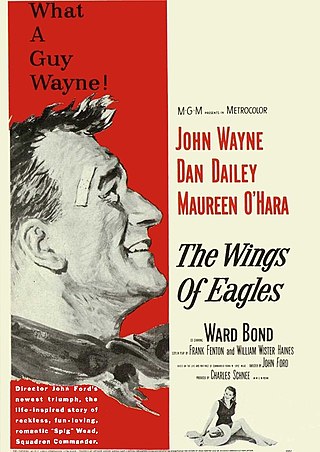
The Wings of Eagles is a 1957 American Metrocolor film starring John Wayne, Dan Dailey and Maureen O'Hara, based on the life of Frank "Spig" Wead and the history of U.S. Naval aviation from its inception through World War II. The film is a tribute to Wead from his friend, director John Ford, and was based on Wead's "We Plaster the Japs", published in a 1944 issue of The American Magazine.

John Elmer Carson, known as Jack Carson, was a Canadian-born American film actor. Carson often played the role of comedic friend in films of the 1940s and 1950s, including The Strawberry Blonde (1941) with James Cagney and Arsenic and Old Lace (1944) with Cary Grant. He appeared in such dramas as Mildred Pierce (1945), A Star is Born (1954), and Cat on a Hot Tin Roof (1958). He worked for RKO and MGM, but most of his notable work was for Warner Bros.

Dennis Morgan was an American actor-singer. He used the acting pseudonym Richard Stanley before adopting the name under which he gained his greatest fame.
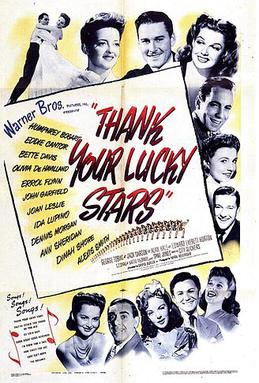
Thank Your Lucky Stars is a 1943 American musical comedy film made by Warner Brothers as a World War II fundraiser, with a slim plot involving theater producers. The stars donated their salaries to the Hollywood Canteen, which was founded by John Garfield and Bette Davis, who appear in this film. It was directed by David Butler and stars Eddie Cantor, Dennis Morgan, Joan Leslie, Edward Everett Horton and S.Z. Sakall.
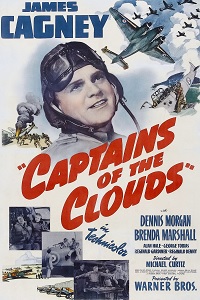
Captains of the Clouds is a 1942 American war film in Technicolor, directed by Michael Curtiz and starring James Cagney. It was produced by William Cagney, with Hal B. Wallis as executive producer. The screenplay was written by Arthur T. Horman, Richard Macaulay, and Norman Reilly Raine, based on a story by Horman and Roland Gillett. The cinematography was by Wilfred M. Cline and Sol Polito and was notable in that it was the first feature-length Hollywood production filmed entirely in Canada.

Going Wild is a 1930 Warner Brothers pre-Code comedy film based on the 1910 play The Aviator by James Montgomery and directed by William A. Seiter. The film stars many musical stars along with Joe E. Brown, Frank McHugh and Johnny Arthur.
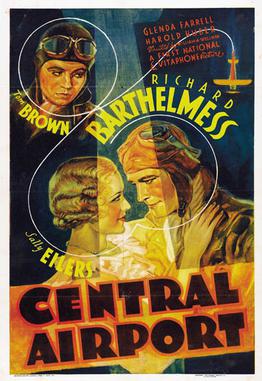
Central Airport is a 1933 American pre-Code aviation drama film directed by William A. Wellman, based on the John C. "Jack" Moffitt story, "Hawk's Mate". The film stars Richard Barthelmess and Sally Eilers. Central Airport was produced and released by Warner Bros., on April 15, 1933. John Wayne had an uncredited part in the film, playing a co-pilot, and this film features his first on-screen death.

Ceiling Zero is a 1936 American adventure drama film directed by Howard Hawks and starring James Cagney and Pat O'Brien. The picture stars Cagney as daredevil womanizing pilot "Dizzy" Davis and O'Brien as Jake Lee, his war veteran buddy and the operations manager of an airline company. Based on a stage play of the same name, the film blends drama with some light comedy. The title, as defined at the beginning of the picture, is an insider term referring to those moments when the sky is so thick with fog that navigating an aircraft is nearly impossible.
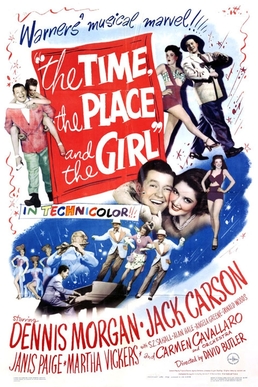
The Time, the Place and the Girl is a 1946 American Technicolor musical comedy film directed by David Butler and starring Dennis Morgan, Jack Carson, Janis Paige and Martha Vickers. The film was produced and distributed by Warner Brothers. It is unrelated to the 1929 film The Time, the Place and the Girl.
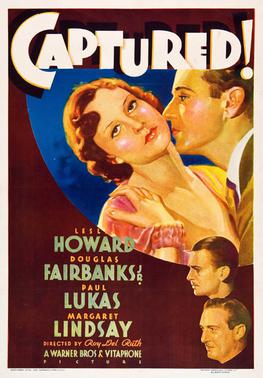
Captured! is a 1933 American pre-Code film about World War I prisoners of war in a German camp. The film was directed by Roy Del Ruth and stars Leslie Howard and Douglas Fairbanks Jr. Captured! was based on the short story "Fellow Prisoners" (1930) by Sir Philip Gibbs.

Shine On, Harvest Moon is a 1944 musical–biographical film about the vaudeville team of Nora Bayes and Jack Norworth, who wrote the popular song "Shine On, Harvest Moon." The film was directed by David Butler and stars Ann Sheridan and Dennis Morgan Sheridan's singing voice was dubbed by Lynn Martin.

Flight Angels is a 1940 commercial aviation film from Warner Bros. Pictures, produced by Edmund Grainger and directed by Lewis Seiler, from an original story by Jerry Wald and Richard Macaulay. The film stars Virginia Bruce, Dennis Morgan, Wayne Morris, and Ralph Bellamy as airline employees, flying Douglas DST airliners.

International Squadron is a 1941 American war film directed by Lewis Seiler and Lothar Mendes that starred Ronald Reagan, Olympe Bradna and in his final film, James Stephenson. The film is based on the Eagle Squadrons, American pilots who volunteered to fly for the Royal Air Force during World War II. International Squadron featured noted Hollywood pilot Paul Mantz who acted as the film's aerial coordinator and flew during the production.

Flying Fortress is a 1942 British black-and-white war film drama from Warner Bros. Pictures, produced by A. H. Soloman, directed by Walter Forde, that stars Richard Greene and co-stars Carla Lehmann, Betty Stockfeld, and Donald Stewart.

Murder in the Air is a 1940 American drama film with science fiction elements directed by Lewis Seiler and written by Raymond L. Schrock. The film stars Ronald Reagan, John Litel, Lya Lys, James Stephenson, Eddie Foy, Jr., Robert Warwick and Victor Zimmerman. Murder in the Air was released by Warner Bros. on June 1, 1940.

One More Tomorrow is a 1946 American drama film directed by Peter Godfrey and written by Charles Hoffman and Catherine Turney from the play The Animal Kingdom by Philip Barry. The film, starring Ann Sheridan, Dennis Morgan, Jack Carson, Alexis Smith, Jane Wyman and Reginald Gardiner. It was released by Warner Bros. on June 1, 1946. A pre-code 1932 film, The Animal Kingdom, is also based on the play.

20,000 Men a Year is a 1939 American action film directed by Alfred E. Green and written by Lou Breslow and Owen Francis. The film stars Randolph Scott, Preston Foster, Margaret Lindsay, Mary Healy, Robert Shaw, George Ernest, Jane Darwell, Kane Richmond and Maxie Rosenbloom. It was the fourth and last film produced by Cosmopolitan Pictures in its final year of operation.

Flight Into Nowhere is a 1938 American adventure film directed by Lewis D. Collins, and produced by Larry Darmour for Columbia Pictures. The film stars Jack Holt, Jacqueline Wells and Dick Purcell. In the low-budget action film, the locale of South America jungles provides an exciting venue for "flyboy" Jack Holt, who is trying to establish a new route for an American airline.

Legion of Lost Flyers is a 1939 American B movie drama film directed by Christy Cabanne. It stars Richard Arlen, Andy Devine, and Anne Nagel. Legion of Lost Flyers was released by Universal Pictures on November 3, 1939.
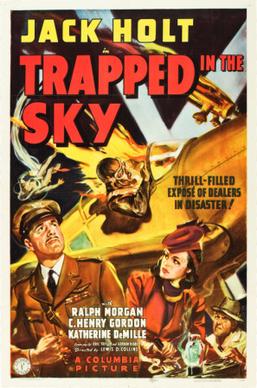
Trapped in the Sky is a 1939 American thriller film directed by Lewis D. Collins and produced by Larry Darmour for Columbia Pictures. The film stars Jack Holt, Ralph Morgan and Katherine DeMille. Holt is the "flyboy" who is trying to find the saboteurs of a "silent" aircraft. The plot device of a "noiseless" or stealthy aircraft is a familiar theme in aviation films of the period, including The Sky Ranger (1921), The Silent Flier (1926) and Eagle of the Night (1928).




















